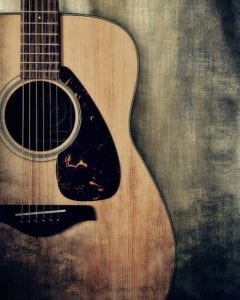Spread the love
- The ancestors of the modern guitar can be traced back to the stringed instruments played across Central Asia and India, in ancient times.
- The oldest iconographic representation of the strumming instrument is a 3,000-year-old carving of a Hittite or ancient Anatolian bard playing the instrument.
- The instrument is believed to have descended from the cithara brought to Hispania by the Romans, in 40 CE.
- The various references to the guitar in ancient times included guitarra, gitarre, guitare, qitara, cithara, kithara, and sihtar.
- Traditionally, they were constructed with combinations of various woods. The strings were made of animal gut.
- The musical instrument has a mention in records maintained by the Moors, Viking incursions, and in traditional Norse carvings.
- Dimension standards of the modern stringed instrument were established by Antonio Torres Jurado, between 1817 and 1892.

Guitar Design Facts
- The various brands of guitars comprise PRS, Dean, Gretsch, Gibson, Ibanez, Jackson, Schecter, and Fender and Martin.
- Classical guitars are typically strung with nylon strings. They have a wide, flat neck for least string interference with scales and arpeggios.
- The Yepes 10-string guitar flaunts four resonators that work in unison with all 12 chromatic notes, to enhance and balance sonority.
- Archtop guitars are carved in a curve rather than the traditional flat shape. They are equipped with magnetic pickups and flat-wound strings.
- Electric guitars are fitted with electromagnetic pickups to convert string vibrations into electrical signals. These are then fed into an amplifier and modified via vacuum tubes.
- Guitars can be constructed for left- and right-handed players. The features are modified accordingly, to enhance the dynamics and tonal expressions.
- Renaissance and Baroque guitars are usually used as rhythm instruments.
- Guitars are designed, constructed, and repaired by luthiers.
- An acoustic guitar emits sound via a soundboard, typically a wooden mount on the front of the design. The subcategories of acoustic guitars include classical and flamenco versions.
- Flat-top or steel-string guitars have reinforced necks that are narrower with a strong structural design. They are an integral part of Folk, Jazz, Country, Bluegrass, Blues, and Pop music.
Guitar Essentials: An Overview

The basic guitar design typically comprises:
- Headstock, at the end of the guitar neck.
- Neck, comprising frets, tuners, fretboard, headstock, and truss rod.
- Nut, a small strip of any hard material at the headstock-fretboard juncture.
- Fretboard or fingerboard.
- Frets, metal strips embedded on the fretboard.
- Truss rod, a metal rod along the inside of the neck.
- Strings made from metal or polymer materials.
- Inlays, visual elements along the exterior surface.
Guitar accessories comprise:
- Capotasto, to open up string pitch.
- Slides, to generate the glissando effect.
- Plectrum, to ‘pick’ the strings.
The guitar is a versatile musical instrument. It enables the composition of complex harmonies and precise intonation. It is a popular choice of musicians dedicated to different music genres for the musical embellishments it promotes, such as slides, bends, and harmonics
Also published on Medium.
Spread the love
